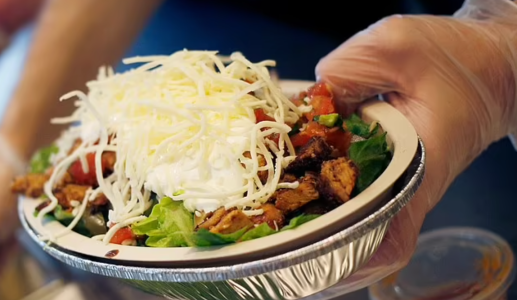Portion sizes at some US restaurant chains, including Chipotle, have been reduced while prices remain high or increase
By
Gian T
- Replies 6
As we gather around the table at our favourite eateries, enjoying the ambience and the company, there's a subtle change afoot that might not be immediately noticeable. It's a shift that's happening quietly, almost imperceptibly, but it affects our wallets and our waistlines. Restaurants, it seems, are serving us less food, but the prices? They're not taking the same downward turn.
This phenomenon isn't entirely new. For years, savvy consumers have whispered about the shrinking sizes of chocolate bars and the ever-so-slight reduction in the number of chips in a packet. But now, this trend has made its way to the restaurant industry, stirring up more than just the soup of the day.
In the United States, a country once synonymous with super-sized meals, the tide is turning. With inflation tightening the purse strings and a growing awareness of the obesity epidemic, some restaurants are cutting back on portion sizes. This isn't just hearsay; some chains are openly admitting to this practice.
Take, for example, the recent uproar over Chipotle's portion sizes. Customers have become so frustrated with what they perceive as stingy servings that they've resorted to filming employees and using male names when ordering in the hope of receiving a more generous helping. It's a sign of the times when diners feel they must employ tactics to get their money's worth.
But it's not just about feeling short-changed. There's a deeper issue at play here. As restaurants rebrand their smaller portions as 'balanced meals' or 'low in calories,' they're also using visual tricks like smaller plates to give the illusion of abundance. It's a clever ruse, but not one that goes unnoticed. Burger King, for instance, has reduced its 10-piece chicken nugget offering to an eight-piece, a subtle change that doesn't escape the discerning eye.
The restaurant industry is at a crossroads, as Chip Wade, CEO of Union Square Hospitality Group, suggests. They're 'getting ready to get ready,' preparing to reevaluate portion sizes in a world where both health and economy are pressing concerns.
Interestingly, a survey by the National Restaurant Association in 2024 found that 75 per cent of customers actually prefer smaller meals, provided the price reflects the portion. It's a reasonable expectation, yet one that's not always met.
Deals like Panera's 'You Pick 2', and Subway's $3 hot wraps are tapping into this desire for smaller, snack-sized meals, especially popular among younger diners. But the challenge remains: how can restaurants offer these smaller meals without compromising on perceived value?
The Portion Balance Coalition at Georgetown University is delving into this conundrum with a year-long study, aiming to find a sweet spot that satisfies both the customer's wallet and their appetite for value.
Food waste is another critical factor driving this change. With around 40 per cent of food served in restaurants ending up in the trash, according to a 2020 study, the financial and environmental costs are staggering. It's a problem that's prompted states like California and Massachusetts to legislate against excessive food waste, though with mixed results.
Amidst these changes, some Americans are turning to appetite-suppressing drugs like Ozempic, leading to even more uneaten food. Social media trends like 'Girl Dinner,' showcasing plates of random, snack-like foods, reflect a shift away from traditional, full-course meals.
Yet, not all chains are on board with downsizing. Kevin Hochman, CEO of Brinker International, which owns Chili's Grill & Bar, believes in giving customers what they want, even if that means sticking with larger portions. It's a sentiment that echoes the comforting excess of a meal at grandma's house, where leaving stuffed is part of the experience.
However, experts like Deborah Cohen, who led a balanced meal study in California, argue that most Americans struggle with portion control when faced with oversized servings. Changing this environment, she believes, is crucial for long-term health outcomes.
As we navigate this landscape of changing portion sizes, it's essential to be aware of these industry practices. Whether you're someone who relishes a hearty meal or prefers a lighter touch on your plate, understanding the motivations behind these changes can help you make informed choices when dining out.
So, dear members of the Seniors Discount Club, next time you're out enjoying a meal, take a moment to consider the portion in front of you. Is it the right size for your appetite and your budget? And if you find yourself with leftovers, remember that they can make for a delicious meal the next day.
 We'd love to hear your thoughts on this topic. Have you noticed a change in portion sizes when dining out? Do you feel that the prices reflect the amount of food you're receiving? Share your experiences in the comments below, and let's discuss how we can all get the best value and enjoyment from our dining experiences.
We'd love to hear your thoughts on this topic. Have you noticed a change in portion sizes when dining out? Do you feel that the prices reflect the amount of food you're receiving? Share your experiences in the comments below, and let's discuss how we can all get the best value and enjoyment from our dining experiences.
This phenomenon isn't entirely new. For years, savvy consumers have whispered about the shrinking sizes of chocolate bars and the ever-so-slight reduction in the number of chips in a packet. But now, this trend has made its way to the restaurant industry, stirring up more than just the soup of the day.
In the United States, a country once synonymous with super-sized meals, the tide is turning. With inflation tightening the purse strings and a growing awareness of the obesity epidemic, some restaurants are cutting back on portion sizes. This isn't just hearsay; some chains are openly admitting to this practice.
Take, for example, the recent uproar over Chipotle's portion sizes. Customers have become so frustrated with what they perceive as stingy servings that they've resorted to filming employees and using male names when ordering in the hope of receiving a more generous helping. It's a sign of the times when diners feel they must employ tactics to get their money's worth.
But it's not just about feeling short-changed. There's a deeper issue at play here. As restaurants rebrand their smaller portions as 'balanced meals' or 'low in calories,' they're also using visual tricks like smaller plates to give the illusion of abundance. It's a clever ruse, but not one that goes unnoticed. Burger King, for instance, has reduced its 10-piece chicken nugget offering to an eight-piece, a subtle change that doesn't escape the discerning eye.
The restaurant industry is at a crossroads, as Chip Wade, CEO of Union Square Hospitality Group, suggests. They're 'getting ready to get ready,' preparing to reevaluate portion sizes in a world where both health and economy are pressing concerns.
Interestingly, a survey by the National Restaurant Association in 2024 found that 75 per cent of customers actually prefer smaller meals, provided the price reflects the portion. It's a reasonable expectation, yet one that's not always met.
Deals like Panera's 'You Pick 2', and Subway's $3 hot wraps are tapping into this desire for smaller, snack-sized meals, especially popular among younger diners. But the challenge remains: how can restaurants offer these smaller meals without compromising on perceived value?
The Portion Balance Coalition at Georgetown University is delving into this conundrum with a year-long study, aiming to find a sweet spot that satisfies both the customer's wallet and their appetite for value.
Food waste is another critical factor driving this change. With around 40 per cent of food served in restaurants ending up in the trash, according to a 2020 study, the financial and environmental costs are staggering. It's a problem that's prompted states like California and Massachusetts to legislate against excessive food waste, though with mixed results.
Amidst these changes, some Americans are turning to appetite-suppressing drugs like Ozempic, leading to even more uneaten food. Social media trends like 'Girl Dinner,' showcasing plates of random, snack-like foods, reflect a shift away from traditional, full-course meals.
Yet, not all chains are on board with downsizing. Kevin Hochman, CEO of Brinker International, which owns Chili's Grill & Bar, believes in giving customers what they want, even if that means sticking with larger portions. It's a sentiment that echoes the comforting excess of a meal at grandma's house, where leaving stuffed is part of the experience.
However, experts like Deborah Cohen, who led a balanced meal study in California, argue that most Americans struggle with portion control when faced with oversized servings. Changing this environment, she believes, is crucial for long-term health outcomes.
As we navigate this landscape of changing portion sizes, it's essential to be aware of these industry practices. Whether you're someone who relishes a hearty meal or prefers a lighter touch on your plate, understanding the motivations behind these changes can help you make informed choices when dining out.
So, dear members of the Seniors Discount Club, next time you're out enjoying a meal, take a moment to consider the portion in front of you. Is it the right size for your appetite and your budget? And if you find yourself with leftovers, remember that they can make for a delicious meal the next day.
Key Takeaways
- Some US restaurant chains, including Chipotle, have admitted to reducing portion sizes while prices remain high or increase.
- Seventy-five per cent of surveyed customers prefer smaller meals for lower prices, and restaurants are exploring options like smaller meals and deals.
- A study is being conducted to understand how restaurants can offer smaller meals without disappointing value-conscious customers.
- Despite a trend towards smaller portions, some restaurants, like those under Brinker International, are choosing to maintain large portion sizes to satisfy customer expectations for ample meals.








